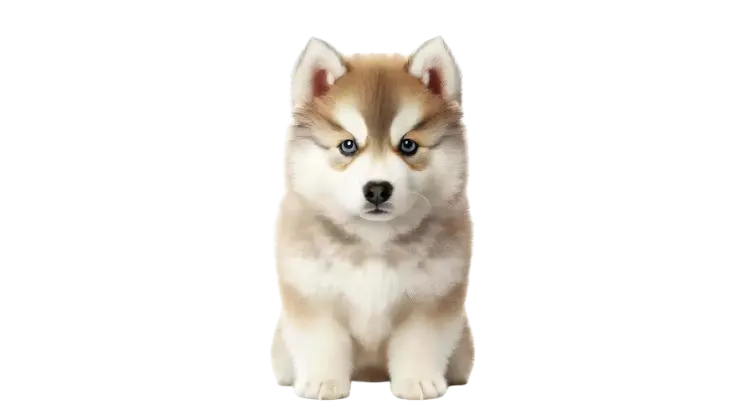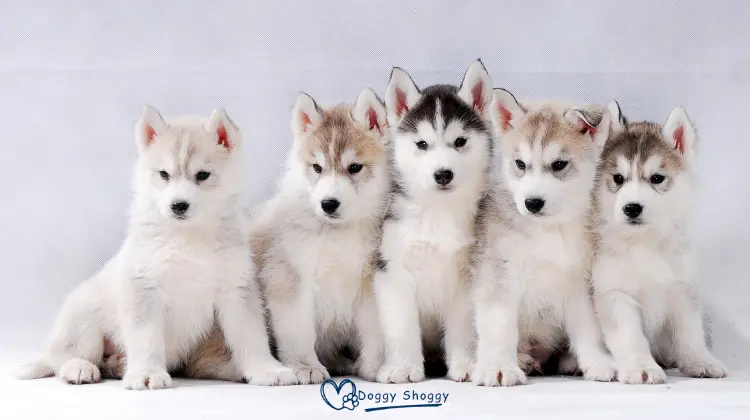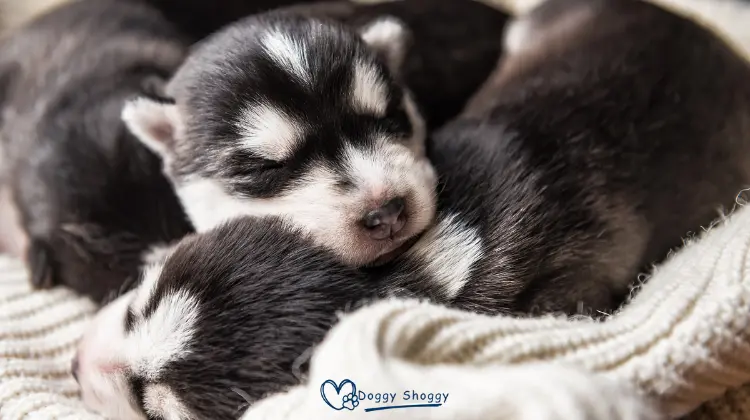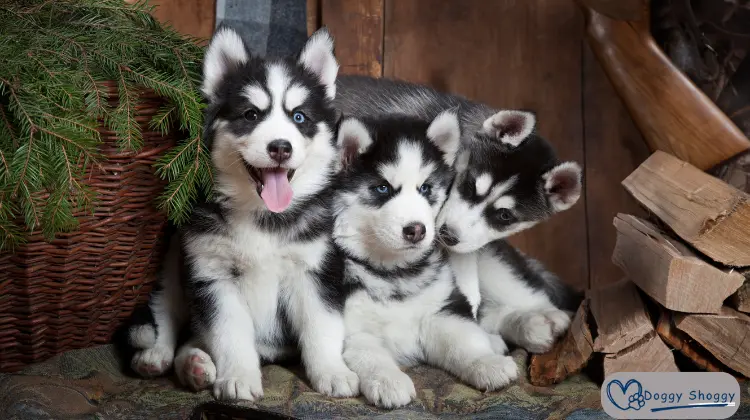Baby Husky | Complete Guide for Owners

Baby Husky
Baby Huskies, or Siberian Husky puppies, are bundles of energy and curiosity. Known for their adorable appearance and expressive faces, these puppies require special care, attention, and understanding to grow into well mannered adult dogs. Baby Husky puppies bring a lot of joy but also require dedicated care to ensure they thrive.
Weight
15-30 lbs
Height
10-15 inches
Lifespan
12-15 years
Breed
Siberian Husky
Characteristics of Baby Huskies
Appearance
Baby Huskies are small, fluffy, and irresistibly cute. They inherit a thick double coat, which is often softer than that of adult Huskies. As they grow, their coat thickens and their facial markings become more defined.
Physical Traits
| Trait | Description |
|---|---|
| Size | Small; typically 1-5 kg at birth, growing rapidly. |
| Coat | Soft, fluffy, in a variety of colors (gray, black, red) |
| Eye Colors | Often start blue; can change to brown or remain blue. |
| Tail | Curly and bushy, often kept warm in sleep. |
Personality Traits
Baby Husky are curious, playful, and eager to explore their surroundings. While they are affectionate, they can also be stubborn and independent from an early age. This personality mix means training should start early to establish good behavior patterns.
Did You Know? Even as puppies, Huskies can exhibit “talking” or vocalization behaviors, using a mix of whines, howls, and barks to communicate their needs or feelings.

History and Origins
Like adult Huskies, baby Husky trace their origins to the cold Siberian climates, where the breed was developed for sledding and endurance. While Siberian Huskies have evolved over thousands of years, their playful and social nature has remained intact. As puppies, they often display high energy and a natural love for adventure.
Living with a Baby Husky
Exercise and Activity Needs
Although young, Husky puppies are surprisingly energetic and need daily exercise to help expend their energy. However, care must be taken to avoid overexertion, as their bones and joints are still developing.
Exercise Recommendations
| Activity Type | Frequency | Duration |
|---|---|---|
| Short Walks | Daily | 10–15 minutes |
| Play Sessions | Several times a day | 5–10 minutes |
| Mental Stimulation | Daily | Puppy puzzles, socialization |
Puppy Tip: Avoid prolonged or strenuous exercise in the first few months to protect the puppy’s growing joints. Play and short, supervised outdoor explorations are usually ideal.
Training Basics
Training a Husky puppy is essential to instill good manners and avoid behavioral issues later. Huskies are intelligent but can be quite independent, so consistent and positive training from an early age helps set boundaries.
Key Training Areas for Baby Huskies
- Potty Training: Huskies need guidance for housebreaking, but consistent routines and patience are effective.
- Crate Training: Helps create a safe space for the puppy and aids in housetraining.
- Basic Commands: Start with commands like “sit,” “stay,” and “come” to build obedience skills.
Training Tip: Use positive reinforcement, such as treats and praise, to encourage good behavior. Avoid harsh corrections, as Huskies respond better to encouragement than punishment.
Grooming Requirements for Baby Huskies
While baby Huskies don’t shed as heavily as adults, they still need regular grooming to maintain a healthy coat. Brushing them early also helps them get accustomed to grooming routines, which is especially useful during their twice yearly shedding periods as they mature.
Basic Grooming Needs for Baby Huskies
| Grooming Task | Frequency |
|---|---|
| Brushing | Once per week |
| Nail Trimming | As needed, around every 3-4 weeks |
| Bathing | Once every few months |
| Ear Cleaning | Monthly |

Feeding and Nutrition
Baby Huskies have specific dietary needs to support their growth. They benefit from a balanced diet rich in proteins, fats, and essential nutrients. Puppy specific food is recommended for the first year to support bone development, muscle growth, and a healthy immune system.
Sample Diet Breakdown for Baby Huskies
| Nutrient Component | Recommended Ratio | Notes |
|---|---|---|
| Protein | 22–28% | Supports muscle growth |
| Fats | 8–10% | Helps with coat and skin health |
| Carbohydrates | Moderate | Provides quick energy |
| Vitamins & Minerals | Puppy formulated food | Supports bone and immune health |
Feeding Tip: Stick to high quality puppy food. Feeding a baby Husky adult dog food can lead to nutritional imbalances, as puppy food is specifically formulated to meet their growing needs.
Feeding Schedule
Husky puppies need small, frequent meals. Gradually increase portion sizes and reduce meal frequency as they grow.
Sample Feeding Schedule for a Baby Husky
| Age | Meals Per Day | Meal Size |
|---|---|---|
| 8–12 weeks | 4 | ¼–½ cup per meal |
| 3–6 months | 3 | ½–¾ cup per meal |
| 6–12 months | 2 | ¾–1 cup per meal |
Health and Common Issues in Baby Huskies
While Husky puppies are generally healthy, they are prone to certain breed specific health issues. Regular vet checkups, a balanced diet, and early training are crucial for ensuring a baby Husky grows up healthy.
Common Health Issues in Baby Huskies
| Health Concern | Symptoms | Prevention / Treatment |
|---|---|---|
| Parvovirus | Vomiting, diarrhea, lethargy | Vaccination and hygiene |
| Hip Dysplasia (hereditary) | Difficulty moving, lameness | Screening, regular exercise |
| Puppy Worms | Weight loss, diarrhea | Deworming under vet guidance |
Health Tip: Ensure your puppy is vaccinated on schedule to prevent common illnesses and keep them away from unfamiliar dogs until fully vaccinated.
Socialization Needs of a Baby Husky
Socialization is essential for raising a well rounded Husky. Exposing your puppy to different people, environments, and situations helps build confidence and reduces anxiety.
Key Socialization Activities for Baby Huskies:
- Meet New People: Invite friends and family over to interact with your puppy.
- Expose to Various Environments: Short trips to parks, pet friendly stores, and other new places.
- Introduce to Other Pets: Positive interactions with other dogs and animals help them learn boundaries and social etiquette.
Socialization Tip: Make sure to pair each new experience with positive reinforcement, such as treats and praise, to help your puppy form positive associations.
Fun Facts About Baby Huskies
Baby Husky puppies are full of quirks and amusing behaviors. They often start vocalizing and “talking” from an early age, mimicking the howls and whines that make adult Huskies famous.
Interesting Fact: Did you know that baby Huskies love digging? This behavior stems from their ancestry as sled dogs, who often dig to find food or shelter.

Preparing for a Baby Husky at Home
Is This the Right Breed for You?
Baby Huskies require a lot of attention, patience, and time. Potential owners should be prepared for a high energy puppy that needs daily exercise, regular training, and constant supervision.
Checklist for New Husky Puppy Owners
| Requirement | Details |
|---|---|
| Safe, Puppy Proofed Area | Essential for avoiding accidents |
| Socialization Plan | Introduce to new environments early |
| Training Supplies | Treats, clicker, toys |
| Grooming Tools | Puppy brush, nail trimmer |
Benefits of Raising a Baby Husky
Raising a Husky puppy can be incredibly rewarding. They are intelligent, loyal, and endlessly entertaining. With the right guidance, baby Huskies can grow into well behaved and loving companions, bringing joy and energy to any home.
This detailed guide provides a comprehensive approach to understanding, caring for, and raising a Husky puppy, offering practical insights and easy to navigate information. From feeding and grooming to socialization and training, new owners will have all the tools they need to provide a happy and healthy environment for their baby Husky.
Bottom Line
Baby Huskies are energetic, intelligent, and adorable pets that require dedicated care and training. They need regular exercise, a balanced diet, and consistent training to grow into well behaved adult dogs. Proper socialization, attention to their health needs, and creating a safe environment will help baby Huskies thrive and become loyal companions.
FAQ’s
How big is a 1 year old husky?
A 1 year old Husky is almost fully grown. Males weigh 45–60 pounds and are 21–23.5 inches tall, while females weigh 35–50 pounds and are 20–22 inches tall.
Does a Husky need AC?
Huskies don’t necessarily need AC, but in very hot climates, a cool environment or AC helps them stay comfortable since they have thick fur.
Is a Husky a dog or wolf?
Huskies are dogs, not wolves. Although they look similar to wolves, they are a distinct breed and are fully domesticated.
Is a 2 year old Husky still a puppy?
A 2 year old Husky is not technically a puppy but may still show puppy-like energy and behavior. They reach full maturity around this age.
